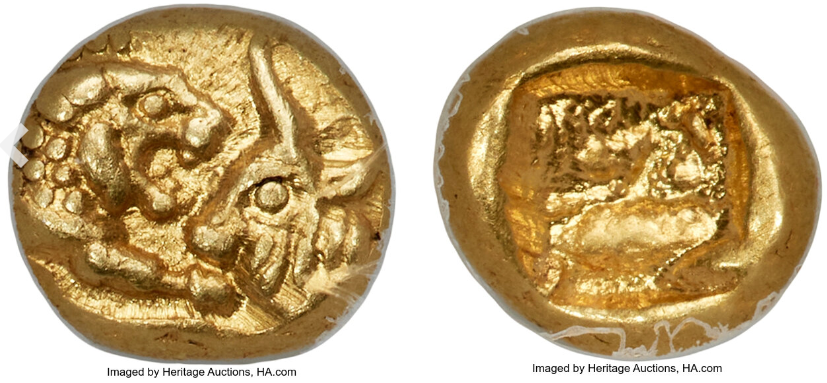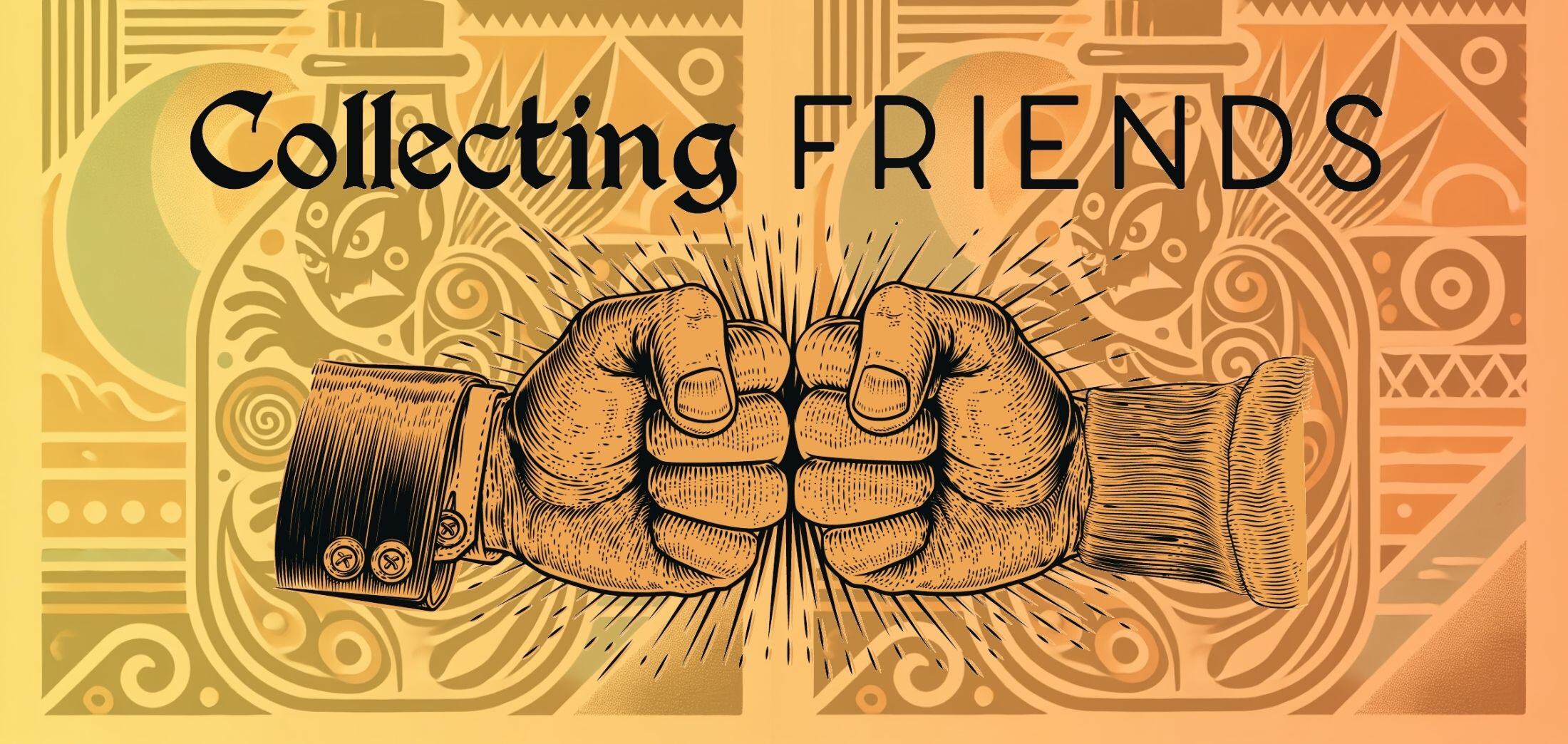Collecting Friends: The Bottle Imp’s Coin Collection
The Bottle Imp's Coins Collection
 Dennis: Steve, a few weeks ago we talked about giant-sized coins in monumental works of public art. Well, I recently came across a tiny coin on the other end of the scale. I received it in change at a bookstore. How tiny is the coin? It’s so small that to make up a dollar, you would need 240 of it.
Dennis: Steve, a few weeks ago we talked about giant-sized coins in monumental works of public art. Well, I recently came across a tiny coin on the other end of the scale. I received it in change at a bookstore. How tiny is the coin? It’s so small that to make up a dollar, you would need 240 of it.
When it comes to size in this case, I’m talking about denomination, not physical dimensions. The coin itself is a decent 20 mm in width, or slightly bigger than a Lincoln cent. What makes it small is its face value: 25 Philippine sentimos, four to a peso. At the time of my bookstore purchase in Manila in the summer of 2024, the peso was running at 60 to the U.S. dollar.
Believe it or not, this little bit of cash isn’t even the smallest of the Philippines’ small change. The Central Bank still mints 5-sentimo coins (20 to the peso) and 1-sentimos (100 to the peso).
[Image: In the Philippines you can buy a pocket dictionary (like the one pictured) for 60 pesos, or about $1 US. It takes four 25-sentimo coins to equal just one peso—very small change.]
The United States has had its share of small denominations over the years. Two-cent pieces and even three-cent coins jingled in the pockets of American consumers in the 1800s. Collectors know coins even smaller in face value: half cents and cents, minted starting in 1793.

[Image: Classic Head half cent, (1809-36), copper.]
Today everyone is familiar with the cent as the smallest of U.S. denominations. Production of half cents stopped in 1857, so it was the Indian Head “penny” that held the distinction as America’s smallest coin back in 1891. That’s the year a strange and wondrously numismatic short story was published by Scottish author Robert Louis Stevenson. He called it “The Bottle Imp.”
The story starts in Hawaii: A poor, brave, and hard-working Native Hawaiian called Keawe decides to “have a sight of the great world and foreign cities,” and travels to San Francisco. There he meets a rich but sad old man, and makes a bargain to purchase an otherworldly bottle from him. The old man attributes his wealth and prosperity to the magical bottle, “tempered in the flames of hell” and with an imp inside. It grants whatever its owner desires, but with rules attached. The bottle must be sold before the owner dies—for a price lower than what he paid, and in coined money—or he’ll be carried off by the demon to burn in hell.
The first owner of the bottle was the legendary medieval Christian elder and king Prester John, who purchased it from Satan for a fortune. Over the centuries its owners achieved their fondest wishes and sold the bottle at a loss, as required to avoid its hellish curse. Captain James Cook owned it, as did Napoleon Bonaparte—though both saw their worldly success ruined after wishing for too much before selling the bottle. Keawe decides to make a modest wish and then immediately sell the bottle without getting greedy.
Coins are mentioned throughout “The Bottle Imp,” making it a delight for numismatists, and they figure prominently as the bottle moves from owner to owner. American cents and silver dollars, Chilean crowns, English farthings, French centimes—it makes you wonder if the bottle imp might have been a coin collector himself! Ultimately the plot hinges on a conundrum: Would you buy such a cursed bottle for the world’s second-smallest coin?
When I started collecting, I read about little bits of money like the 1904 “Panama pill” (2-1/2 centesimos), Canadian “fish scales” (silver five-cents), and other very small coins.
Steve, have your travels crossed paths with any coins or paper notes that are tiny, either in physical size or face value?
Steve: Dennis, what a wonderful prompt as I’ve been looking for a way to express my appreciation for the tiny fractional gold coins issued in ancient Greece during the Archaic Period. Using the gold stater as a base denomination of the period, the 1/12 stater is a physically tiny coin typically weighing well-under a gram with a diameter of just 6 to 8 millimeters. Heritage sold a particularly gorgeous example of this 1/12 stater, also called a hemihecte, graded by NGC Ancients as Gem Mint State, with 5/5 ratings for strike and surface quality. Struck in Croesus around 550 B.C., as part of the Lydian Kingdom in Asia Minor, Heritage pointed out its perfect centering and “glistening, velveteen flan.”
 Weighing just .67 grams and measuring 6 millimeters across, it sits in its slab like a baby trying on a XXL shirt. The die engraving is amazing with the heads of a lion and bull confronting one another on one side, and the reverse showing an incuse square punch with irregular interior surfaces, showing how it was made. As the ANA’s Edward C. Rochette Money Museum’s exhibit on the history of money explains, “The Lydian coins feature a simple incuse depression on the reverse that was created during the minting process by hammering a punch used to force the blank planchet into the anvil die.” [Image: This 1/12 stater issued in ancient Greece around 550 B.C. has a diameter of just 6 millimeters, as seen in this normal-sized NGC slab.]
Weighing just .67 grams and measuring 6 millimeters across, it sits in its slab like a baby trying on a XXL shirt. The die engraving is amazing with the heads of a lion and bull confronting one another on one side, and the reverse showing an incuse square punch with irregular interior surfaces, showing how it was made. As the ANA’s Edward C. Rochette Money Museum’s exhibit on the history of money explains, “The Lydian coins feature a simple incuse depression on the reverse that was created during the minting process by hammering a punch used to force the blank planchet into the anvil die.” [Image: This 1/12 stater issued in ancient Greece around 550 B.C. has a diameter of just 6 millimeters, as seen in this normal-sized NGC slab.]
This one was exceptional, selling for $19,200 at Heritage’s August 17, 2023, ANA World and Ancient Coins Platinum Night session. More typical examples can be found for well-under $1,000. Especially considering the microscopic work that had to be done to make the dies, and the lack of the type of tools an engraver might use today to complete this work, coins like it are even more remarkable. The artisan clearly took care beyond what their peers were doing, taking pride in the work to create some personality in the animals. Further, the high-detail die work made it nearly impossible to counterfeit, and the blend of pride and precision, along with them being nearly 3,000 years old, makes these tiny marvels. [Image below: Croesus (561-546 BC). AV 1/12 stater or hemihecte (6mm, 0.67 gm). Courtesy Heritage Auctions.]

Be on the lookout for another installment of Collecting Friends next month or subscribe here and never miss a post! In the meantime, explore beautiful coins from the ANA's Edward C. Rochette Money Museum Virtual Exhibits.
About the Collecting Friends Blog
Hello! And welcome to the ANA’s blog series, “Collecting Friends.”
We decided to approach this much like a conversation between friends. One of us starts with a topic, then the other responds. Simple as that. Along those lines, we’ll keep the tone conversational as much as possible.
We both write about coins professionally, and will keep our relative style guides in our writing. For Dennis, Publisher at Whitman Publishing, that means capitalizing “Proof” and italicizing Red Book and never saying anything bad about Ken Bressett, who’s awesome anyway.
For Steve, who’s written with Coin World for 15 years, it means Winged Liberty Head dime instead of “Mercury” dime, and similar nuances and oddities. And, it means writing A Guide Book of United States Coins (better known as the “Red Book”).
Both of us started collecting when we were little, introduced to coins by a chance encounter with an old coin that sparked our curiosity. One of Steve’s interests is coin valuation, and he gravitates towards the intersection of art and coins. Dennis enjoys medals and world coins, and studying modern U.S. coins in the context of older series, what came before.
We met in 2012 at the American Numismatic Association World’s Fair of Money in Philadelphia at an event hosted by the Austrian Mint where there was both a Ben Franklin and a Betsy Ross impersonator. We’ve become great friends in the past decade. We even were appointed together to sit on the Citizens Coinage Advisory Committee starting in 2016, but Steve resigned soon after he was appointed to accept a full-time job at the Treasury Department while Dennis was re-appointed in 2020.
We taught a course together on numismatic publishing and writing a few years ago at the Summer Seminar, and while life has gotten in the way of us teaching another class, we jumped at our friend Caleb’s suggestion that we write a column. We hope you enjoy it!
.png?width=300&height=300&name=steve%20roach%20circle%20frame%20(2).png)
.png?width=300&height=300&name=dennis%20tucker%20circle%20frame%20(2).png)
About the American Numismatic Association
The American Numismatic Association is a nonprofit organization dedicated to educating and encouraging people to study and collect coins and related items. The Association serves collectors, the general public, and academic communities with an interest in numismatics.
The ANA helps all people discover and explore the world of money through its vast array of educational programs including its museum, library, publications, conventions and numismatic seminars.

